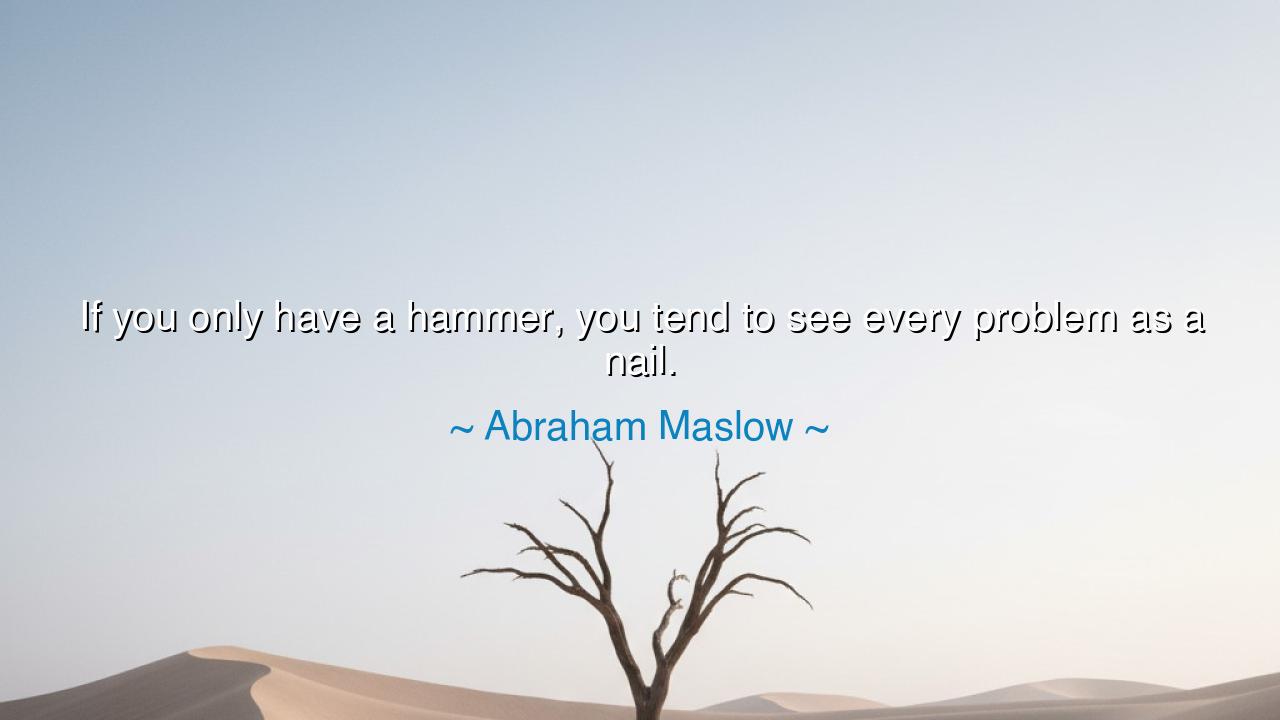
If you only have a hammer, you tend to see every problem as a






Hearken, children of the ages, and ponder the words of Abraham Maslow: “If you only have a hammer, you tend to see every problem as a nail.” In this utterance lies the timeless truth of perspective, tools, and the limitations of singular thinking. The mind, like the craftsman, perceives the world through the instruments it wields. When one clings solely to a single method or belief, all challenges appear to conform to that approach, and the subtleties of reality are obscured. True wisdom lies in diversity of understanding and flexibility of thought.
The origin of this teaching springs from Maslow’s work in psychology, particularly his insights into human needs and behavior. He observed that individuals often approach life with a narrow toolkit, applying familiar solutions indiscriminately. In doing so, they fail to appreciate the complexity and uniqueness of each problem. Maslow’s words warn against the danger of rigid thinking, urging us to cultivate a broad and adaptable mind, capable of discerning the right method for each circumstance.
Consider the tale of Leonardo da Vinci, whose genius lay not only in mastery of one craft, but in the union of many disciplines—painting, engineering, anatomy, and invention. Were he to have relied on a single skill alone, the Mona Lisa would never have been painted with such depth, nor the machines conceived with such foresight. Da Vinci exemplifies Maslow’s truth: the wise see beyond the hammer, employing a spectrum of tools to meet the demands of each challenge.
Even in daily life, this teaching resonates. A leader who only knows confrontation will approach every dispute as a battle; a physician who knows only one treatment will apply it to every ailment; a teacher who relies on a single method will reach few minds. The limitation is not in the problem, but in the narrowness of perception and the poverty of approach. Maslow reminds us that adaptability and awareness expand the power of human endeavor.
History offers further examples: consider George Washington, who faced diverse threats in war and governance. He employed diplomacy, strategy, and patience, understanding that no single approach sufficed. Had he relied solely on force, he would have failed. His success reflects the wisdom of choosing the right tool for the task, and the danger of seeing all problems through a single lens.
Therefore, children of future generations, take this counsel to heart: cultivate a mind enriched with many tools, sharpened by experience and reflection. Let not the hammer alone blind you to the forms of the world; seek understanding, versatility, and discernment. In doing so, you honor the eternal principle that wisdom lies in adaptability, not in rigidity, and that every problem demands its own measured and thoughtful response.






HEhieu eyyy
Education and training often reward depth in a single method, which quietly trains the habit this line critiques. How do you cultivate range without diluting mastery? I’m thinking T-shaped development, cross-functional rotations, and performance reviews that praise appropriate tool choice rather than sheer velocity. Would you institute periodic “tool audits” where teams catalog what they overuse, what they underuse, and what they should retire? Bonus: a small fund for oddball experiments that challenge the house style. What incentives make pluralism the default?
MHkim thi minh hang
On a personal level, I’m noticing my own rigidity. I frame fitness as a discipline problem and try harder; maybe it’s actually about environment design or social accountability. Could we sketch a mini-toolkit for everyday dilemmas—if willpower stalls, try friction changes; if motivation wobbles, try identity cues; if overwhelm spikes, try constraint setting? I’m experimenting with a “tool-fast” week: avoid my default method and journal what emerges. What reflection prompts help distinguish stubbornness from expertise, and novelty seeking from productive exploration?
NBHai Nguyen Bui
Policy choices feel especially vulnerable here. When enforcement is the default instrument, everything looks like a compliance issue—when some problems need prevention, services, or negotiation. How would you structure a “tool mix” review for recurring civic challenges like housing, addiction, or traffic deaths? I want criteria that weigh speed, dignity, equity, and downstream costs, not just headline impact. Also, what accountability loop retires ineffective levers—sunset clauses, independent audits, or mandatory pilots—so we don’t keep applying force where design or support would work better?
TLThang Le
In product and engineering, this lands hard. I’ve seen teams reach for their comfort stack—say, microservices or machine learning—when a cron job or SQL view would solve the problem. Could you outline a design doc template that forces pluralism: list at least two architectures, estimate total cost of ownership, and specify a rollback plan? I’m also interested in culture. What norms reduce prestige pressure to pick flashy tools—blameless postmortems, small reversible bets, or celebrating boring reliability? How do you keep craftsmanship without fetishizing complexity?
LALe Anh
As a reader, I hear a warning about “instrument bias”—the way our favorite methods colonize our thinking. I’m curious: what diagnostics help you notice when your go-to approach is misfiring? Maybe a pre-decision checklist that asks, “What would prove this tool inappropriate? Which alternative frames produce different first moves?” I’d love a simple ritual: generate three non-obvious options, run a quick cost-of-being-wrong estimate, and invite one outsider to critique assumptions. How do you balance expertise (depth) with tool diversity (breadth) without sliding into analysis paralysis?